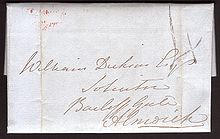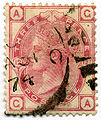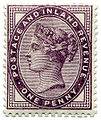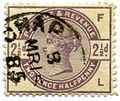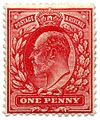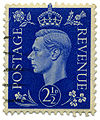Postage stamps and postal history of Great Britain
Postage Stamps and Postal History of Great Britain provides an overview of the postal history of the United Kingdom of Great Britain and (Northern) Ireland, as well as the postage stamps that have been issued by that country and its former territories to date.
The postal history of the United Kingdom of Great Britain and Ireland (since 1927 Great Britain and Northern Ireland) is remarkable in at least one way, because of the invention of the postage stamp in 1840, which paved the way for more modern postal systems.
The beginnings
The story begins in the 12th century with Henry I of England who appointed messengers to deliver letters for the government. Between 1100 and 1135, an estimated 4,500 letters were delivered by these messengers. At that time, private individuals had to take their own precautions. Henry III. equipped the messengers with uniforms and Eduard I set up post houses where they could change their horses. During the reign of Edward II , the first postal marks came up - handwritten notes, the said "Haste, post haste" ("Haste, post haste").
Henry VIII founded the Royal Mail , the royal postal service, in 1516 and appointed Brian Tuke "Master of the Postes". Elisabeth I then appointed Thomas Randolph as "Chief Postmaster". Under Thomas Witherings, the chief postmaster during the reign of Charles I, the Royal Mail was made accessible to the general public with a regulated system of post roads, post houses and employees in 1635. From that point on until the postal reforms of 1839–1840, it was common that the recipient paid the postage. However, it was also possible to pay the fee when sending the item.
In 1661 Charles II appointed Henry Bishop as the first post minister. Because of customer complaints about late letters, Bishop introduced the so-called Bishop stamp. It was a small circle marked with the month and day. It was first used in London , in the main post office and in the foreign department and was soon adopted in Scotland (Edinburgh) and Ireland (Dublin). In the years that followed, the postal system expanded from six streets to a nationwide network. Post offices were established in both large and small towns, each with its own postmark .
In 1680 William Dockwra founded the London Penny Post, a mail delivery service that delivered letters and parcels weighing no more than a pound within London and the immediately adjacent suburbs for a penny.
- Excursus on the British currency
The currency unit is the pound sterling. It is identified by the symbol £, a stylized “L” derived from “libra”, the Latin word for pound. Up until February 1971 a pound consisted of twenty shillings (20s or 20 / -). The slash (/) is derived from the previously common long s and both symbols embody the Latin term " solidus ". One shilling consisted of twelve pence (12d). The “d” stands for “ denarius ”, the Latin word for a ten ace coin. Since 1971, the still existing pound has been divided into one hundred pence, which for a number of years was called the "new" pence. Today they are simply called "pence" and are represented by the symbol "p". Without taking inflation into account, the following applies: 2.4d. = 1p and 1 / - = 5p.
Postage stamps
Rowland Hill advocated the great postal reform of 1839 and 1840 to turn the Post's steady financial losses into profits. Hill convinced Parliament to introduce the Fourpenny Post uniform, which charged a flat rate of 4d per ½ ounce regardless of the distance (10s 8d per pound for heavier items). This price was in effect from December 5, 1839, but remained in effect for only 36 days. This was immediately successful and on January 10, 1840, the Penny Post uniform went into service, which cost only 1d for postage paid in advance and 2d for postage paid by the recipient. Thanks to the unit prices, it was no longer possible to pay with cash when sending letters, but to use a “sticker” instead. On May 6th, the Penny Black was the world's first postage stamp to be used.
Originally, the postage stamp was only intended for use within the United Kingdom of Great Britain and Ireland and therefore was initially actually a domestic postage stamp. Because of this, the name of the country is not included on it. In agreement with foreign post offices, this practice was maintained as long as the stamp bore the image of the ruler.
This did not apply to pre-franked envelopes, which is why the name of the country was noted on them. The words “Britain” could be read on the special commemorative stamps for the Festival of Britain in 1951. At this time, the name of the country was therefore for the first time on a stamp from the United Kingdom of Great Britain and Northern Ireland. The designation "British", however, was already to be read in 1924 on the commemorative stamps in memory of the British colonial exhibition (British Empire Exhibition).
It soon became apparent that black was not a good choice as a stamp color, as the stamps on it were difficult to see, and from 1841 the stamps were printed in brick red. These penny reds stayed around for decades.
Victorian era
There was a veritable explosion of experimentation and innovation during the Victorian Age. Since it was laborious to cut the stamps from the sheet with scissors, attempts were made with piercing (Archer's piercing machine) and later perforation. The latter became the standard procedure in 1854. 1847 were treated with the (octagonal) of 1-Schilling mark (0.05 £) the first British stamps with embossing issued. The next year 10d stamps followed and in 1854 6d stamps (£ 0.025).
With a 4d postage stamp printed by De La Rue , a letterpress stamp was first published in 1855, which later became the standard printing process. The ½d (halfpenny) and 1½d (penny halfpenny - pronunciation: Pennyhaypny or Threehaypence) stamps, which appeared in 1870, were the last engraved copies with Queen Victoria ; the next ones weren't released until 1913. For the letterpress stamps from the 60s and 70s of the 19th century, the same profile of Victoria, but a whole range of different frames, watermarks and corner letters, was used.
In 1867 a 5 shilling stamp (abbreviation: 5 / - or 5s.) (£ 0.25) appeared for the first time; This was followed in 1878 by a 10 shilling postage stamp (£ 0.50) and a £ 1 postage stamp, and the culmination was a £ 5 postage stamp in 1882.
Meanwhile, with the termination of the Perkins Bacon printing contract, the age of the Penny Reds was over. The new postage stamps with low postage values were also produced in relief printing. The first was a square-framed Venetian red penny stamp released in 1880. Because of the Customs and Tax Act passed in 1881, new postage stamps were required, which also served as postage stamps. That is why the Penny Lilac with the inscription “POSTAGE AND INLAND REVENUE” (“Postage and Taxes”) was published this year.
This stamp remained the standard postage stamp for the rest of the Victorian reign and was printed in huge numbers. Later editions bore the inscription "POSTAGE & REVENUE" which later became the more familiar "POSTAGE REVENUE".
In 1883 and 1884, the purple and green edition experimented with colors that fade in water. The designs were rather simple, with purple stamps for the low postage values and green for the high postage values, because these were the only two colors available.
They served their purpose - very few of these brands survived use because the colors fade when they are deviated from the envelope - but they were not popular with the general public.
The last major edition with Victoria was the edition for her jubilee in 1887. It is a set of twelve drafts between ½d. and 1s., which were mostly printed in two colors or on colored paper. (They were released in the year of the throne jubilee, but not specifically for the occasion, so they are not commemorative.)
Early 20th century
When Edward VII ascended the throne, new postage stamps were needed. However, the approach was extremely conservative: the frames of most of the jubilee stamps were reused and the portrait of the king was still a simple profile. The reign of King Edward was comparatively short; there were no significant design changes, but chalk paper was introduced (this type of paper can be detected by rubbing silver over the surface and leaving a black mark).
In contrast, George V's postage stamps were innovative from the start. The first issue included stamps with postage values between ½d and 1d, the color of which corresponded to those from the reign of his predecessor. Although the main features of the design - a centrally arranged ellipse for the portrait, a decorative frame, the postage field below and a crown above - remained unchanged, a three-quarter profile portrait was used for the first time. However, in the subsequent drafts, the standard profile was used again.
The first commemorative stamps from the United Kingdom of Great Britain and Ireland appeared in 1924 on the occasion of the British Empire Exhibition. The two large-format stamps, on which a lion can be seen in a striking pose, were issued twice - in 1924 and 1925 - with the year of issue being noted on the stamps. A second set of commemorative stamps from 1929 commemorates the 9th Congress of the Universal Postal Union, which took place in London that year.
1½d postage stamp with George V from 1912; Used in Wootton Wawen in Warwickshire in 1928 .
Abdication and war
A set of four stamps was issued for Edward VIII in 1936 before his abdication. A commemorative stamp commemorates the coronation of George VI . It was part of a bus series that included all the colonies of the British Empire. The new definitive stamps showed a profile of the king, based on a plaster cast made by Edmund Dulac, against a plain background. They are the forerunners of the Machin editions published three decades later (see below).
1940 was with a set of six stamps, the Viktoria and Georg VI. Side by side shows the one hundredth anniversary of the stamp. The following year, wartime requirements influenced stamp printing. The stamps from 1937 look a lot lighter because they were printed with less color. Post-war editions include the 1948 commemorative stamps for the Restoration of Peace, the King's Silver Wedding and the 1948 Summer Olympics, and the 1949 Universal Postal Union commemorative stamp for the 75th anniversary.
In 1950, the colors of all low postage stamps changed. In 1951 a new series with high postage amounts (2s 6d, 5s, 10s, £ 1) and two commemorative stamps for the "Festival of Britain" were released.
Under Elizabeth II
When Elizabeth II succeeded her father to the throne in 1952, new postage stamps were required. The result was a series of variations on a theme called wilding editions . They are based on a portrait of Queen Elizabeth II taken by the photographer Dorothy Wilding.
The Wilding tokens remained in use until 1967, and the Machin editions were introduced on June 5 of that year . Machin's design is very simple - it shows a profile view of the queen against a plain background - and very popular. It still adorns the British standard postage stamp to the present day. Experts differentiate between hundreds of different variants of this mark because it was printed in innumerable colors, the changeover to the decimal system required new denominations and there were also several technical improvements in the printing process.
British Postage Stamp Design Trends
Until the 1950s there were only a few British commemorative stamps . Most postage stamps were definitive, the most important element of which was a portrait of the reigning monarch. Even as commemorative stamps became more common in the 1950s and early 1960s, the portrait of the monarch remained a distinctive feature. It typically took up between a quarter and a third of the space on the postage, which limited the versatility and creativity of the designs. That changed in 1965 when Tony Benn, the Secretary of the Post Office, set new criteria for acceptable postage images. The graphic artist David Gentleman turned to Benn with alternative design approaches and suggested replacing the monarch's head with another national symbol, for example a crown, royal initials or lettering such as “Great Britain” or “UK”. As a compromise solution, a small silhouette of the queen created by Mary Gillick was accepted, which was otherwise used on coins and has since then been commonly depicted on commemorative stamps. If the portrait of the monarch is a main design element of the stamp (such as on the issues on the occasion of the queen's birthday), then the silhouette is superfluous and is not used. An exception to this rule came in 2000 when a commemorative sheet was published to mark the Queen Mother's 100th birthday, which included a postage stamp with a photograph of the Queen and the silhouette.
Another trend is the increasing use of postage stamps to commemorate events related to the current royal family. Until Elizabeth II ascended to the throne in 1952, the commemorative stamps for the silver jubilee of George V from 1935 and for the coronation of George VI. from 1937 and an edition from 1948 on the occasion of the silver wedding anniversary of George VI. the only commemorative stamps to mark events in the royal family. However, since 1952, commemorative stamps have been issued for numerous occasions related to the royal family. In addition, commemorative stamps appeared after the deaths of Princess Diana (1998) and Queen Mother Elisabeth (2002).
With regard to former monarchs, stamps were issued in 1987 to mark the 150th anniversary of Queen Victoria’s accession to the throne and in 1997 to commemorate the 450th anniversary of Henry VIII's death. Between 2008 and 2011 postage stamps were issued with portraits of all English kings and queens as well as the Scottish House of Stuart.
Regional editions
From 1958 regional editions were introduced in the Channel Islands, the Isle of Man, Northern Ireland, Scotland and Wales. Although these editions are only sold in local post offices, the editions from Northern Ireland, Scotland and Wales are valid throughout the United Kingdom of Great Britain and Northern Ireland. The Channel Islands (since 1969, Alderney since 1983) and the Isle of Man (since 1973) now have their own postal administrations and issue their own postage stamps that are only valid there. In January 2001, the Royal Mail also introduced regional editions for England, which are only sold at post offices in the English part of the country but are valid throughout the United Kingdom.
The UK Post Abroad
Great Britain had overseas post offices in other nations' territories in the late 19th and early 20th centuries. British definitive stamps with overprints were often used. Post offices abroad with their own stamp issues existed in Bangkok until 1885, China until 1922/30, Crete 1898/99 (locally printed stamps), Madagascar until 1896, Morocco and Tangier until 1957 and the Ottoman Empire until 1914 Century in Central and South America and up to the 1960s in the Middle East. Responsibility for the post offices abroad was usually the main post office in London, but it was temporarily transferred to subordinate offices in neighboring British colonies.
Individual evidence
- ↑ a b c Key Dates . The British Postal Museum & Archives. Archived from the original on April 26, 2012. Info: The archive link was inserted automatically and has not yet been checked. Please check the original and archive link according to the instructions and then remove this notice. Retrieved July 23, 2009.
- ↑ William Dockwra and the Penny Post Service . Canadian Museum of Civilization. Retrieved November 8, 2010.
- ^ Glossary of Stamp Collecting Terms . AskPhil.org - Collectors Club of Chicago. Archived from the original on June 28, 2011. Info: The archive link was inserted automatically and has not yet been checked. Please check the original and archive link according to the instructions and then remove this notice. Retrieved November 23, 2009.
- ↑ George V Commemorative Issue: Wembley British Empire Exhibition . The British Postal Museum & Archives. Archived from the original on May 5, 2011. Info: The archive link was inserted automatically and has not yet been checked. Please check the original and archive link according to the instructions and then remove this notice. Retrieved July 22, 2009.
- ^ King George V Commemorative Issue: Postal Union Congress 1929 . The British Postal Museum & Archives. Archived from the original on April 27, 2020. Info: The archive link was inserted automatically and has not yet been checked. Please check the original and archive link according to the instructions and then remove this notice. Retrieved July 22, 2009.
- ↑ Edward VIII stamps . The British Postal Museum & Archives. Archived from the original on September 3, 2009. Info: The archive link was inserted automatically and has not yet been checked. Please check the original and archive link according to the instructions and then remove this notice. Retrieved July 23, 2009.
- ↑ George VI stamps . The British Postal Museum & Archives. Archived from the original on April 26, 2012. Info: The archive link was inserted automatically and has not yet been checked. Please check the original and archive link according to the instructions and then remove this notice. Retrieved July 23, 2009.
- ↑ A New Portrait - Timeless & Classic: Elizabeth Queen & Icon . The British Postal Museum & Archives. Archived from the original on April 4, 2012. Info: The archive link was inserted automatically and has not yet been checked. Please check the original and archive link according to the instructions and then remove this notice. Retrieved July 23, 2009.
- ^ Timeless & Classic: Elizabeth Queen & Icon . The British Postal Museum & Archives. Archived from the original on April 4, 2012. Info: The archive link was inserted automatically and has not yet been checked. Please check the original and archive link according to the instructions and then remove this notice. Retrieved July 23, 2009.
- ^ A Revolution in British Stamp Design - Gentleman on Stamps . The British Postal Museum & Archives. Archived from the original on August 14, 2009. Info: The archive link was inserted automatically and has not yet been checked. Please check the original and archive link according to the instructions and then remove this notice. Retrieved July 22, 2009.
- ↑ British Postal Museum & Archive ( Memento of the original from January 3, 2011 in the Internet Archive ) Info: The archive link was automatically inserted and not yet checked. Please check the original and archive link according to the instructions and then remove this notice.
- ^ Lions, Leopards, Unicorns & Dragons: The first "Regional" stamps . The British Postal Museum & Archives. Archived from the original on August 11, 2009. Info: The archive link was inserted automatically and has not yet been checked. Please check the original and archive link according to the instructions and then remove this notice. Retrieved July 23, 2009.
- ↑ Page on the 25th anniversary of the first own stamps , accessed on November 19, 2015
- ↑ Page of the GB Collectors Club ( Memento of the original from September 24, 2015 in the Internet Archive ) Info: The archive link was automatically inserted and not yet checked. Please check the original and archive link according to the instructions and then remove this notice. Retrieved November 19, 2015
literature
- Whitney, JT Collect British Postmarks. British Postal Identification Society, 1979.
- Manual dictionary of postal services 2nd edition from 1953, pp. 335–338

